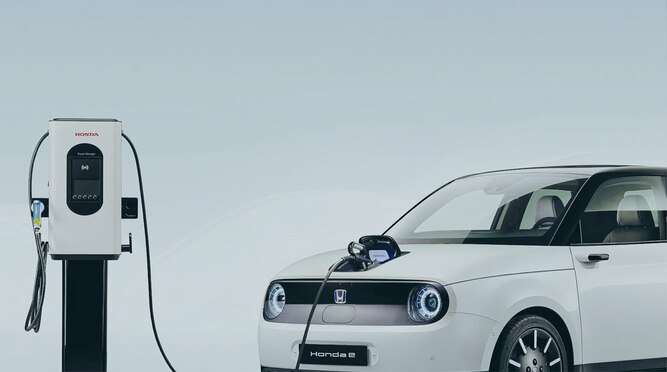Response to TCFD Recommendations

In treating responses to climate change and energy-related issues as crucial in the environmental field, in April 2021, Honda announced, its vision to “realize carbon neutrality for all products and corporate activities Honda is involved in by 2050.”
Hence, we have declared our support to the Task Force on Climaterelated Financial Disclosures (TCFD), established by the Financial Stability Board (FSB), as well as disclosing information based on the information disclosure framework recommended by the TCFD.
The recommended disclosures for the core elements of the framework - Governance, Strategy, Risk Management and Metrics and Targets - are listed at the end of the relevant text. We will continue to promote the disclosure of information related to climate change, while conducting scenario analysis on climate change risks and opportunities and reflecting the results in our management strategies.
Governance
Monitoring System by Directors
As climate change may have a significant impact on Honda’s business performance as a whole, we hold annual World Environment and Safety Strategy Committee meetings. The Committee monitors long-term policies, targets, strategies, and progress related to climate change and other environmental and safety issues. The total CO2 emissions reduction targets set by the Committee are reported to and supervised by the Board of Directors.
Please refer to “Remuneration Structure for Directors and Executive Officers” of Honda Report 2023 p.61 to understand our remuneration structure for Directors and Executive Officers, which takes into account ESG aspects. TCFD Governance Recommendation a
TCFD Governance Recommendation a : Describe the board's oversight of climate related risks and opportunities.
Roles of Top Management Members
The World Environment and Safety Strategy Committee is chaired by the CEO, who has ultimate responsibility for addressing climate change issues. The Committee deliberates on PDCA for each region, the risks and opportunities concerning climate change, energy and resources, as well as the short-, medium- and long-term environmental strategies based on them. Global medium- to long-term environmental policies and plans are also proposed based on company-wide policies and medium- to long-term management plans.
In addition, important matters are resolved by the Executive Council and reported to the Board of Directors. TCFD Governance Recommendation b
TCFD Governance Recommendation b : Describe management’s role in assessing and managing climaterelated risks and opportunities.
Strategies
Climate change has wide-ranging impacts, not just on the automobile industry but on people’s living environment and lifestyles too. To evaluate and examine the impacts of climate change on business, Honda utilizes a scenario analysis noted in the TCFD recommendations. This scenario analysis takes 2030 as the target year and identifies climate change risks and opportunities for Honda under multiple scenarios, including a net-zero scenario. The identified risks and opportunities are reflected in our corporate strategy, together with the strategies of each business.
Scenario Analysis Overview
Honda has defined multiple scenarios – including 1.5°C and 4°C scenarios – to assume a progressive worldview and to envision applicable changes to the business environment in the future. Our scenario analyses on the motorcycle, automobile and power products businesses have identified various risks and opportunities for each, based on the transition and physical risks and opportunities described in the TCFD recommendations. TCFD Strategy Recommendation a
Based on the risks and opportunities identified, we have carried out an examination of the degree of impact on financial conditions over the short-, medium- and long-term. A failure to make an appropriate response to the anticipated events as described by each scenario will pose a risk to our business. Nonetheless, we are undertaking initiatives so that we can generate new business opportunities by advancing Honda’s technologies, products and services. In order to minimize damage or the risk of incurring damage caused by a natural disaster, we will promote the establishment of a stable production structure via a robust global value chain. From 2023, Honda has started operating an internal carbon pricing (ICP) system to further accelerate the reduction of CO2 emissions at its Japanese business sites. The carbon price is set at 15,000 yen per metric ton of CO2, while the amount of carbon reduction is converted into a monetary value that can be utilized as one of the factors when making capital investment decisions. TCFD Strategy Recommendation b
To achieve more sustainable corporate management, Honda is examining current response measures to the aforementioned risks and opportunities and improving the resilience of its strategies. Honda has developed strategies based on multiple scenarios. The Company utilizes these strategies in undertaking business, seeks to reduce risks and create opportunities and promotes resilient products and services. TCFD Strategy Recommendation c
TCFD Strategy Recommendation a : Describe the climate-related risks and opportunities the organization has identified over the short, medium, and long term.
TCFD Strategy Recommendation b : Describe the impact of climate-related risks and opportunities on the organization’s businesses, strategy, and financial planning.
TCFD Strategy Recommendation c : Describe the resilience of the organization’s strategy, taking into consideration different climate-related scenarios, including a 2 °C or lower scenario.
Climate Scenarios Used by Honda
1.5°C Scenario
By using the Net Zero Emissions Scenario (NZE) of the IEA and the IPCC AR6 SSP1-1.9, we have developed our 1.5°C scenario.
- As part of the 1.5°C scenario, we assume that measures to achieve carbon neutrality by 2050 will be promoted across the world, resulting in the widespread use of carbon-free products and renewable energy.
- In the automobile industry, we assume even more stringent regulations on fuel efficiency and zero-emission vehicles (ZEVs), and, as a result, producing a rise in demand for electric vehicles (EVs) and fuel cell vehicles (FCVs) — although mainly in developed countries. Additionally, the transition to a circular economy is assumed to accelerate.
- Furthermore, in parallel with the tightening of regulations, we assume that customers’ sense of value will shift, with an increasing number developing a preference for carbon-free products, such as EVs and FCVs, and services too.
- As decarbonization approaches, we also assume advances in renewable energy and energy-saving clean technologies, as well as the growth of their widespread use.
4°C Scenario
We have developed our 4°C scenario by using IPCC AR6 SSP3-7.0.
- In the 4°C scenario, we assume that irreversible environmental changes will occur, leading to more frequent and more severe natural disasters.
Key Risks and Opportunities for Honda
Risk
| Risk | Time frame* |
||
|---|---|---|---|
| 1.5℃ | Policy and regulations |
|
Short- /medium- /long-term |
| Changes in customers' sense of value |
|
||
| Changes in technology |
|
Short- / medium- term |
|
| 4℃ | More frequent and severe natural disasters |
|
Long-term |
For timeframe, short, medium and long mean less than one year, one to less than three years and three years or longer, respectively
Opportunity
| Opportunity | Time frame* |
||
|---|---|---|---|
| 1.5℃ | Policy and regulations |
|
Short- /medium- /long-term |
| Changes in customers' sense of value |
|||
| Changes in technology |
|
Short- / medium term |
|
| 4℃ | More frequent and severe natural disasters |
|
Long-term |
For timeframe, short, medium and long mean less than one year, one to less than three years and three years or longer, respectively
Responses
| Responses | ||
|---|---|---|
| 1.5℃ | Policy and regulations |
Honda Report 2023 p.10, p.18 (PDF: 10.3MB)
Honda Report 2023 p.18 (PDF: 10.3MB)
Honda Report 2023 p.19, p23, p.25 (PDF: 10.3MB)
Honda Report 2023 p.18, p.23, p.54 (PDF: 10.3MB)
|
| Changes in customers' sense of value |
||
| Changes in technology |
Honda Report 2023 p10, p29, p30 (PDF: 10.3MB)
|
|
| 4℃ | More frequent and severe natural disasters |
|
Risk Management
At Honda, “climate change-related risks” are positioned as one of the company-wide priority risks, which include the environmental risk such as stricter environmental regulations, and natural disaster risk such as earthquakes, floods, etc.
The response to climate change-related risks is being driven by the Corporate Planning Unit, the responsible department. They are responsible for organizing information on the progress of environmental measures discussed and coordinated between Business Operations and Regional Operations as well as globally relevant themes. For example, regulatory risks are managed not only with respect to existing regulations but to new ones as well. Regarding the investigation, evaluation and monitoring of the risk of natural disasters, all manufacturing sites are evaluated for water risk using the AQUEDUCT tool of the World Resources Institute (WRI) and the Water Risk Filter tool of the World Wide Fund for Nature (WWF).
The World Environment and Safety Strategy Committee (Secretariat: Corporate Planning Unit), which is in charge of company-wide environmental strategies, is attended by the company-wide Risk Management Officer and formulates global medium- to long-term environmental policies, targets and plans, which are then decided by the Executive Council. In addition, the World Environment and Safety Strategy Committee confirms progress and performance against key environmental targets and formulates policies for addressing issues. Important matters are decided by the Executive Council and reported to the Board of Directors.
Each Business Operation and Regional Office formulates and executes implementation plans based on the global medium to long-term environmental policies.
Each Business Operation establishes an Environmental Responsible Officer and an Environmental Affairs Office, creating a cross-functional structure within the respective business operations. With this framework in place, they develop and promote business plans that incorporate environmental measures.
Each Regional Operation formulate and execute plans based on information shared during the World Environment and Safety Strategy Committee as well as the “the Six Region Environmental Secretariat Committee.” When devising these plans, discussions take place primarily in the “Regional Environmental Committee,” where alignment is sought among various Operations in collaboration with each other. All risks related to corporate activities are managed within the “Risk Management Committee,” chaired by the company-wide Risk Management Officer. This committee encompasses risks associated with climate change as well. While ensuring alignment with the company-wide risk management activities, we are continuously enhancing environmental management, including climate change-related risks. TCFD Risk Management Recommendation c
Regarding the risk assessment and management process within the company-wide risk management activities, please refer to “Governance | Risk Management” of Honda Report 2023 p.64, p.65 for more information. TCFD Risk Management Recommendation a and b
TCFD Risk Management Recommendation a : Describe the organization’s processes for identifying and assessing climaterelated risks.
TCFD Risk Management Recommendation b : Describe the organization’s processes for managing climaterelated risks.
TCFD Risk Management Recommendation c : Describe how processes for identifying, assessing, and managing climaterelated risks are integrated into the organization’s overall risk management.
Environmental Management Structure, including Climate-Related Risks and Opportunities

Metrics and Targets
Metrics for Risks and Opportunities
By 2050, Honda is seeking to realize carbon neutrality for all products and corporate activities the Company is involved with. As the world’s largest power unit manufacturer with total annual sales of approximately 30 million units in the motorcycle, automobile, power product, outboard engine and aircraft fields, we have been working to develop carbon-neutral power sources for a broad range of products.
In order to make steady progress toward carbon neutrality by 2050, Honda has defined corresponding targets and has been promoting efforts accordingly. For CO2 emissions during product use, a target for CO2 emissions intensity has been set for 2030, in addition to the current target, representing global sales share of electrified products. In the area of corporate activities, we aim to reduce our total CO2 emissions by 46% from FY2020. To achieve this target, we will promote initiatives to such as improving production efficiency, implementing energy-saving measures, shifting to low-carbon energy and the use of renewable energy.
Additionally, for water resources vulnerable to climate change, we are giving consideration to water supply risk that affects our businesses, together with depletion risk that impacts areas surrounding our production bases. Hence, we will undertake initiatives to reduce our industrial water intake. TCFD Metrics and Targets Recommendation a
TCFD Metrics and Targets Recommendation a : Disclose the metrics used by the organization to assess climate- related risks and opportunities in line with its strategy and risk management process.
Target to Achieve Zero Environmental Impact
| Target for 2030 TCFD Metrics and Targets Recommendation a |
|||
|---|---|---|---|
|
Reduction rate of total CO2 emissions from corporate activities (compared to FY2020) |
46% | ||
| Sales ratio of electrified products | Motorcycles 15% |
Automobiles 30% |
Power products 36% |
|
Reduction rate of CO2 emissions intensity of product use (compared to FY2020) |
Motorcycles 34.0% |
Automobiles 27.2% |
Power products 28.2% |
|
Reduction rate of total waste generation in corporate activities (compared to BAU) |
14.5% | ||
|
Reduction rate of total water intake in corporate activities (compared to BAU) |
14.5% | ||
| Product resource circulation | Set internal milestones | ||
TCFD Metrics and Targets Recommendation a : Disclose the metrics used by the organization to assess climate- related risks and opportunities in line with its strategy and risk management process.
| Target for 2050 TCFD Metrics and Targets Recommendation c |
|||
|---|---|---|---|
|
Reduction rate of total CO2 emissions from corporate activities (compared to FY2020) |
Net zero CO2 emissions | ||
| Sales ratio of electrified products | |||
|
Reduction rate of CO2 emissions intensity of product use (compared to FY2020) |
|||
|
Reduction rate of total waste generation in corporate activities (compared to BAU) |
Zero industrial waste | ||
|
Reduction rate of total water intake in corporate activities (compared to BAU) |
Zero industrial water intake | ||
| Product resource circulation | Use of sustainable materials 100% |
||
TCFD Metrics and Targets Recommendation c : Describe the targets used by the organization to manage climaterelated risks and opportunities and performance against targets.
Honda's GHG Emissions TCFD Metrics and Targets Recommendation b
Honda believes that calculating and disclosing its greenhouse gas (GHG) emissions as a responsible mobility company is a necessary step for proactively promoting GHG emissions reduction efforts across the world.
Given our business characteristics, our value chain produces large emissions, including those from product use. As such, it is important to calculate and disclose Scope 3 emissions. Consequently, we calculate and disclose emissions from our value chain (Scope 3), in addition to direct (Scope 1) and indirect (Scope 2) Honda emissions.
We will continue to identify and manage related data, which will be utilized to implement GHG emissions reduction measures.
TCFD Metrics and Targets Recommendation b : Disclose Scope 1, Scope 2, and, if appropriate, Scope 3 greenhouse gas (GHG) emissions, and the related risks.
Honda's GHG Emissions
| (million t-CO2e) | FY2020 | FY2021 | FY2022 | FY2023 |
|---|---|---|---|---|
| Emissions from the entire value chain | 331.2 | 254.48 | 280.02 | 288.23 |
| Scope 1 | 1.24 | 1.12 | 1.16 | 1.09 |
| Scope 2 | 3.79 | 3.38 | 3.14 | 2.73 |
| Scope 3 | 298.09 | 249.98 | 275.72* | 284.41 |
- The definitions of Scopes 1, 2 and 3 are provided in the GHG Protocol.
-
Scopes 1&2: Direct and indirect GHG emissions from the corporate activities of Honda Motor Co., Ltd. and its consolidated subsidiaries and affiliated companies in and outside of Japan, excluding some small companies. See Honda ESG Data Book p.137 for details.
ESG Data Book p.137 (PDF: 8.9MB) - The Scope 3 figures are the sum of emissions from categories 1, 2, 3, 4, 5, 6, 7, 9, 10, 11, 12 and 15.
We changed the calculation method of Scope 3 Category 11 emissions from FY2022. See Honda ESG Data Book p.136 for details.
ESG Data Book p.136 (PDF: 8.9MB)



